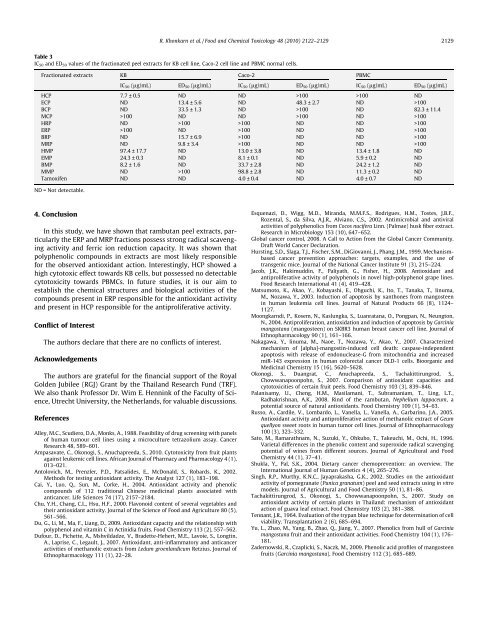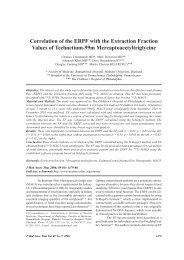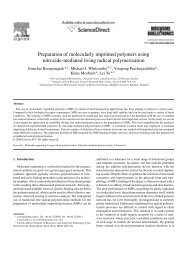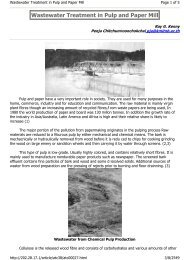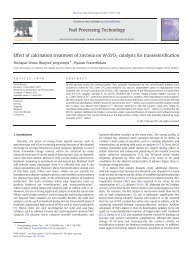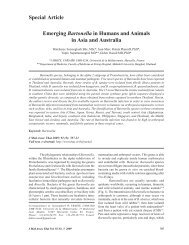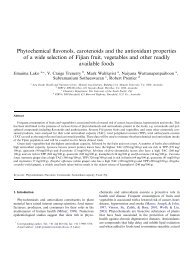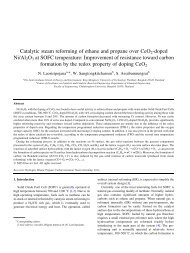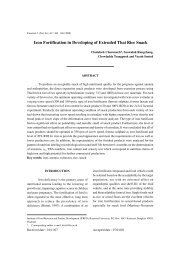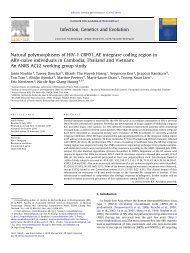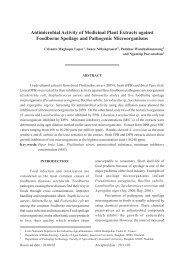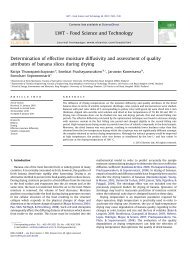Investigation of fruit peel extracts as sources for ... - ThaiScience
Investigation of fruit peel extracts as sources for ... - ThaiScience
Investigation of fruit peel extracts as sources for ... - ThaiScience
Create successful ePaper yourself
Turn your PDF publications into a flip-book with our unique Google optimized e-Paper software.
Table 3<br />
IC 50 and ED 50 values <strong>of</strong> the fractionated <strong>peel</strong> <strong>extracts</strong> <strong>for</strong> KB cell line, Caco-2 cell line and PBMC normal cells.<br />
Fractionated <strong>extracts</strong> KB Caco-2 PBMC<br />
IC50 (lg/mL) ED50 (lg/mL) IC50 (lg/mL) ED50 (lg/mL) IC50 (lg/mL) ED50 (lg/mL)<br />
HCP 7.7 ± 0.5 ND ND >100 >100 ND<br />
ECP ND 13.4 ± 5.6 ND 48.3 ± 2.7 ND >100<br />
BCP ND 33.5 ± 1.3 ND >100 ND 82.3 ± 11.4<br />
MCP >100 ND ND >100 ND >100<br />
HRP ND >100 >100 ND ND >100<br />
ERP >100 ND >100 ND ND >100<br />
BRP ND 15.7 ± 6.9 >100 ND ND >100<br />
MRP ND 9.8 ± 3.4 >100 ND ND >100<br />
HMP 97.4 ± 17.7 ND 13.0 ± 3.8 ND 13.4 ± 1.8 ND<br />
EMP 24.3 ± 0.3 ND 8.1 ± 0.1 ND 5.9 ± 0.2 ND<br />
BMP 8.2 ± 1.6 ND 33.7 ± 2.8 ND 24.2 ± 1.2 ND<br />
MMP ND >100 98.8 ± 2.8 ND 11.3 ± 0.2 ND<br />
Tamoxifen ND ND 4.0 ± 0.4 ND 4.0 ± 0.7 ND<br />
ND = Not detectable.<br />
4. Conclusion<br />
In this study, we have shown that rambutan <strong>peel</strong> <strong>extracts</strong>, particularly<br />
the ERP and MRP fractions possess strong radical scavenging<br />
activity and ferric ion reduction capacity. It w<strong>as</strong> shown that<br />
polyphenolic compounds in <strong>extracts</strong> are most likely responsible<br />
<strong>for</strong> the observed antioxidant action. Interestingly, HCP showed a<br />
high cytotoxic effect towards KB cells, but possessed no detectable<br />
cytotoxicity towards PBMCs. In future studies, it is our aim to<br />
establish the chemical structures and biological activities <strong>of</strong> the<br />
compounds present in ERP responsible <strong>for</strong> the antioxidant activity<br />
and present in HCP responsible <strong>for</strong> the antiproliferative activity.<br />
Conflict <strong>of</strong> Interest<br />
The authors declare that there are no conflicts <strong>of</strong> interest.<br />
Acknowledgements<br />
The authors are grateful <strong>for</strong> the financial support <strong>of</strong> the Royal<br />
Golden Jubilee (RGJ) Grant by the Thailand Research Fund (TRF).<br />
We also thank Pr<strong>of</strong>essor Dr. Wim E. Hennink <strong>of</strong> the Faculty <strong>of</strong> Science,<br />
Utrecht University, the Netherlands, <strong>for</strong> valuable discussions.<br />
References<br />
Alley, M.C., Scudiero, D.A., Monks, A., 1988. Fe<strong>as</strong>ibility <strong>of</strong> drug screening with panels<br />
<strong>of</strong> human tumour cell lines using a microculture tetrazolium <strong>as</strong>say. Cancer<br />
Research 48, 589–601.<br />
Amp<strong>as</strong>avate, C., Okonogi, S., Anuchapreeda, S., 2010. Cytotoxicity from <strong>fruit</strong> plants<br />
against leukemic cell lines. African Journal <strong>of</strong> Pharmacy and Pharmacology 4 (1),<br />
013–021.<br />
Antolovich, M., Prenzler, P.D., Patsalides, E., McDonald, S., Robards, K., 2002.<br />
Methods <strong>for</strong> testing antioxidant activity. The Analyst 127 (1), 183–198.<br />
Cai, Y., Luo, Q., Sun, M., Corke, H., 2004. Antioxidant activity and phenolic<br />
compounds <strong>of</strong> 112 traditional Chinese medicinal plants <strong>as</strong>sociated with<br />
anticancer. Life Sciences 74 (17), 2157–2184.<br />
Chu, Y.H., Chang, C.L., Hsu, H.F., 2000. Flavonoid content <strong>of</strong> several vegetables and<br />
their antioxidant activity. Journal <strong>of</strong> the Science <strong>of</strong> Food and Agriculture 80 (5),<br />
561–566.<br />
Du, G., Li, M., Ma, F., Liang, D., 2009. Antioxidant capacity and the relationship with<br />
polyphenol and vitamin C in Actinidia <strong>fruit</strong>s. Food Chemistry 113 (2), 557–562.<br />
Dufour, D., Pichette, A., Mshvildadze, V., Bradette-Hehert, M.E., Lavoie, S., Longtin,<br />
A., Laprise, C., Legault, J., 2007. Antioxidant, anti-inflammatory and anticancer<br />
activities <strong>of</strong> methanolic <strong>extracts</strong> from Ledum groenlandicum Retzius. Journal <strong>of</strong><br />
Ethnopharmacology 111 (1), 22–28.<br />
R. Khonkarn et al. / Food and Chemical Toxicology 48 (2010) 2122–2129 2129<br />
Esquenazi, D., Wigg, M.D., Miranda, M.M.F.S., Rodrigues, H.M., Tostes, J.B.F.,<br />
Rozental, S., da Silva, A.J.R., Alviano, C.S., 2002. Antimicrobial and antiviral<br />
activities <strong>of</strong> polyphenolics from Cocos nucifera Linn. (Palmae) husk fiber extract.<br />
Research in Microbiology 153 (10), 647–652.<br />
Global cancer control, 2008. A Call to Action from the Global Cancer Community.<br />
Draft World Cancer Declaration.<br />
Hursting, S.D., Slaga, T.J., Fischer, S.M., DiGiovanni, J., Phang, J.M., 1999. Mechanismb<strong>as</strong>ed<br />
cancer prevention approaches: targets, examples, and the use <strong>of</strong><br />
transgenic mice. Journal <strong>of</strong> the National Cancer Institute 91 (3), 215–224.<br />
Jacob, J.K., Hakimuddin, F., Paliyath, G., Fisher, H., 2008. Antioxidant and<br />
antiproliferative activity <strong>of</strong> polyphenols in novel high-polyphenol grape lines.<br />
Food Research International 41 (4), 419–428.<br />
Matsumoto, K., Akao, Y., Kobay<strong>as</strong>hi, E., Ohguchi, K., Ito, T., Tanaka, T., Iinuma,<br />
M., Nozawa, Y., 2003. Induction <strong>of</strong> apoptosis by xanthones from mangosteen<br />
in human leukemia cell lines. Journal <strong>of</strong> Natural Products 66 (8), 1124–<br />
1127.<br />
Moongkarndi, P., Kosem, N., K<strong>as</strong>lungka, S., Luanratana, O., Pongpan, N., Neungton,<br />
N., 2004. Antiproliferation, antioxidation and induction <strong>of</strong> apoptosis by Garcinia<br />
mangostana (mangosteen) on SKBR3 human bre<strong>as</strong>t cancer cell line. Journal <strong>of</strong><br />
Ethnopharmacology 90 (1), 161–166.<br />
Nakagawa, Y., Iinuma, M., Naoe, T., Nozawa, Y., Akao, Y., 2007. Characterized<br />
mechanism <strong>of</strong> [alpha]-mangostin-induced cell death: c<strong>as</strong>p<strong>as</strong>e-independent<br />
apoptosis with rele<strong>as</strong>e <strong>of</strong> endonucle<strong>as</strong>e-G from mitochondria and incre<strong>as</strong>ed<br />
miR-143 expression in human colorectal cancer DLD-1 cells. Bioorganic and<br />
Medicinal Chemistry 15 (16), 5620–5628.<br />
Okonogi, S., Duangrat, C., Anuchapreeda, S., Tachakittirungrod, S.,<br />
Chowwanapoonpohn, S., 2007. Comparison <strong>of</strong> antioxidant capacities and<br />
cytotoxicities <strong>of</strong> certain <strong>fruit</strong> <strong>peel</strong>s. Food Chemistry 103 (3), 839–846.<br />
Palanisamy, U., Cheng, H.M., M<strong>as</strong>ilamani, T., Subramaniam, T., Ling, L.T.,<br />
Radhakrishnan, A.K., 2008. Rind <strong>of</strong> the rambutan, Nephelium lappaceum, a<br />
potential source <strong>of</strong> natural antioxidants. Food Chemistry 109 (1), 54–63.<br />
Russo, A., Cardile, V., Lombardo, L., Vanella, L., Vanella, A., Garbarino, J.A., 2005.<br />
Antioxidant activity and antiproliferative action <strong>of</strong> methanolic extract <strong>of</strong> Geum<br />
quellyon sweet roots in human tumor cell lines. Journal <strong>of</strong> Ethnopharmacology<br />
100 (3), 323–332.<br />
Sato, M., Ramarathnam, N., Suzuki, Y., Ohkubo, T., Takeuchi, M., Ochi, H., 1996.<br />
Varietal differences in the phenolic content and superoxide radical scavenging<br />
potential <strong>of</strong> wines from different <strong>sources</strong>. Journal <strong>of</strong> Agricultural and Food<br />
Chemistry 44 (1), 37–41.<br />
Shukla, Y., Pal, S.K., 2004. Dietary cancer chemoprevention: an overview. The<br />
International Journal <strong>of</strong> Human Genetics 4 (4), 265–276.<br />
Singh, R.P., Murthy, K.N.C., Jayaprak<strong>as</strong>ha, G.K., 2002. Studies on the antioxidant<br />
activity <strong>of</strong> pomegranate (Punica granatum) <strong>peel</strong> and seed <strong>extracts</strong> using in vitro<br />
models. Journal <strong>of</strong> Agricultural and Food Chemistry 50 (1), 81–86.<br />
Tachakittirungrod, S., Okonogi, S., Chowwanapoonpohn, S., 2007. Study on<br />
antioxidant activity <strong>of</strong> certain plants in Thailand: mechanism <strong>of</strong> antioxidant<br />
action <strong>of</strong> guava leaf extract. Food Chemistry 103 (2), 381–388.<br />
Tennant, J.R., 1964. Evaluation <strong>of</strong> the trypan blue technique <strong>for</strong> determination <strong>of</strong> cell<br />
viability. Transplantation 2 (6), 685–694.<br />
Yu, L., Zhao, M., Yang, B., Zhao, Q., Jiang, Y., 2007. Phenolics from hull <strong>of</strong> Garcinia<br />
mangostana <strong>fruit</strong> and their antioxidant activities. Food Chemistry 104 (1), 176–<br />
181.<br />
Zadernowski, R., Czaplicki, S., Naczk, M., 2009. Phenolic acid pr<strong>of</strong>iles <strong>of</strong> mangosteen<br />
<strong>fruit</strong>s (Garcinia mangostana). Food Chemistry 112 (3), 685–689.


